MSI Z77A-GD65 Gaming Review
by Ian Cutress on April 18, 2013 12:00 PM EST- Posted in
- Motherboards
- MSI
- Z77
Readers of our motherboard review section will have noted the trend in modern motherboards to implement a form of MultiCore Enhancement / Acceleration / Turbo (read our report here) on their motherboards. This does several things – better benchmark results at stock settings (not entirely needed if overclocking is an end-user goal), at the expense of heat and temperature, but also gives in essence an automatic overclock which may be against what the user wants. Our testing methodology is ‘out-of-the-box’, with the latest public BIOS installed and XMP enabled, and thus subject to the whims of this feature. It is ultimately up to the motherboard manufacturer to take this risk – and manufacturers taking risks in the setup is something they do on every product (think C-state settings, USB priority, DPC Latency / monitoring priority, memory subtimings at JEDEC). Processor speed change is part of that risk which is clearly visible, and ultimately if no overclocking is planned, some motherboards will affect how fast that shiny new processor goes and can be an important factor in the purchase.
For reference, the MSI Z77A-GD65 Gaming does enable a form of MCT at stock settings.
3D Movement Algorithm Test
The algorithms in 3DPM employ both uniform random number generation or normal distribution random number generation, and vary in various amounts of trigonometric operations, conditional statements, generation and rejection, fused operations, etc. The benchmark runs through six algorithms for a specified number of particles and steps, and calculates the speed of each algorithm, then sums them all for a final score. This is an example of a real world situation that a computational scientist may find themselves in, rather than a pure synthetic benchmark. The benchmark is also parallel between particles simulated, and we test the single thread performance as well as the multi-threaded performance.

With MCT enabled, the GD65 Gaming hits 3DPM Single Threaded in the middle of the pack at a score of 126.
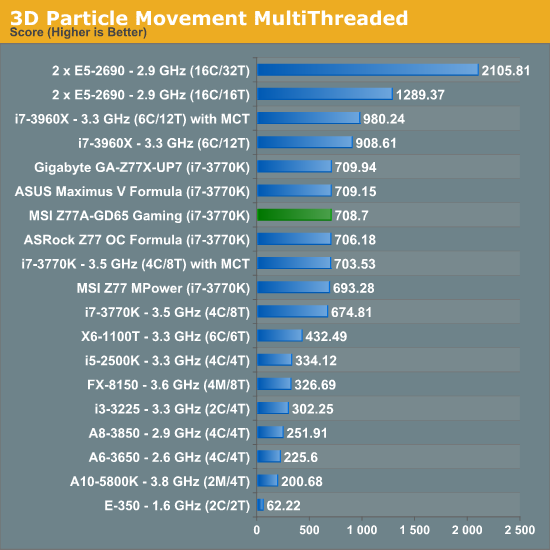
The GD65 Gaming performs well in 3DPM Multithreaded, almost approaching efficiencies seen on the high end ASUS and Gigabyte motherboards.
WinRAR x64 3.93 - link
With 64-bit WinRAR, we compress the set of files used in the USB speed tests. WinRAR x64 3.93 attempts to use multithreading when possible, and provides as a good test for when a system has variable threaded load. If a system has multiple speeds to invoke at different loading, the switching between those speeds will determine how well the system will do.
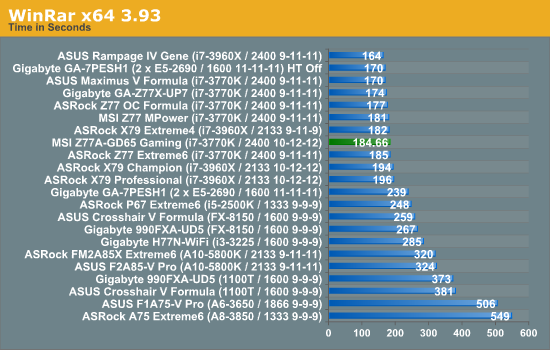
Unfortunately that efficiency in 3DPM is not seen that much in WinRAR, although 184 seconds is no slouch.
Please note we will be updating to WinRAR 4.2 for Haswell. The GD65 Gaming scored 49.65 seconds with v4.2.
FastStone Image Viewer 4.2 - link
FastStone Image Viewer is a free piece of software I have been using for quite a few years now. It allows quick viewing of flat images, as well as resizing, changing color depth, adding simple text or simple filters. It also has a bulk image conversion tool, which we use here. The software currently operates only in single-thread mode, which should change in later versions of the software. For this test, we convert a series of 170 files, of various resolutions, dimensions and types (of a total size of 163MB), all to the .gif format of 640x480 dimensions.
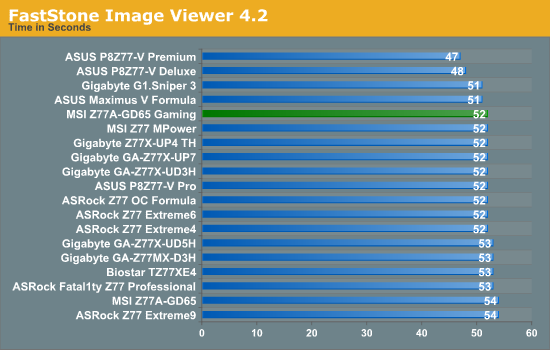
52 seconds is very average for the GD65 Gaming.
Xilisoft Video Converter
With XVC, users can convert any type of normal video to any compatible format for smartphones, tablets and other devices. By default, it uses all available threads on the system, and in the presence of appropriate graphics cards, can utilize CUDA for NVIDIA GPUs as well as AMD APP for AMD GPUs. For this test, we use a set of 32 HD videos, each lasting 30 seconds, and convert them from 1080p to an iPod H.264 video format using just the CPU. The time taken to convert these videos gives us our result.

x264 HD Benchmark
The x264 HD Benchmark uses a common HD encoding tool to process an HD MPEG2 source at 1280x720 at 3963 Kbps. This test represents a standardized result which can be compared across other reviews, and is dependant on both CPU power and memory speed. The benchmark performs a 2-pass encode, and the results shown are the average of each pass performed four times.
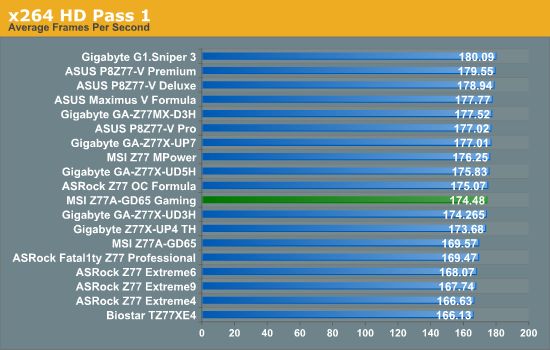
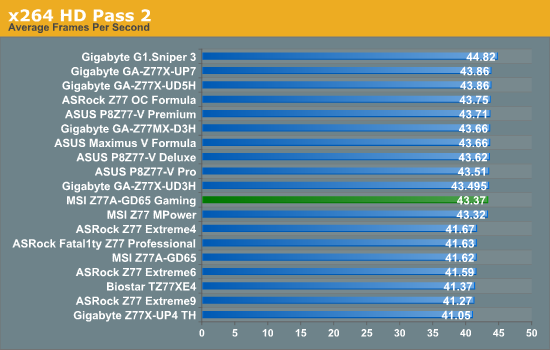










37 Comments
View All Comments
IanCutress - Friday, April 19, 2013 - link
The x8/x8 + x4 vs. x8/x4/x4 difference will only showcase for those that need the PCIe slots, and I hope I have pointed this out in every review I have written. The x8 requirement for SLI will definitely feature in my future reviews, and I will be testing it on Haswell for you.After speaking with MSI, they *will* (because I'll hunt them down) be updating their website to make it more obvious to users. A lot of reviews will just go to the back end and copy/paste of the specifications rather than going through them like we try to do, to see where reality meets purpose. In recent months I have found a few glaring errors with both websites and manuals (!).
Ian
Sunstorm - Friday, April 19, 2013 - link
Many thanks Ian. The quality of the reviews here, as well as interactions like this between commentators and the authors are what really make you guys stand out as pretty much the best tech site out there, in my opinion. I'm glad that I have potentially flagged up this SLI issue that has not come up before.WeaselITB - Friday, April 19, 2013 - link
Wow, kudos on this. I'm not really in the market for a new motherboard (and I'm more of a ROG fan, anyway), but this sort of interaction is exactly why I keep reading Anandtech. Awesome.-Weasel
just4U - Thursday, April 18, 2013 - link
Realtek Sound?I noticed the SoundBlaster Cinema Sticker there yet it says Onboard sound is Realtek. Is it software emulation like what you see out of Asus? Or like Gigabyte's Killer series where it really is a SoundBlaster chip?
IanCutress - Friday, April 19, 2013 - link
Software Emulation; the Soundblaster Cinema software package is part of software stack, and enabled it by default. We had to disable it to run our RMAA audio tests properly as it interfered and raised an interchannel leakage error.Ian
just4U - Wednesday, April 24, 2013 - link
Such a shame.. MSI, use the real thing ok? That goes double for you Asus. Doesn't have to be SoundBlaster either but come on these are supposed to be a step above.benbenkr - Friday, April 19, 2013 - link
Why did you guys not test DPC latency on this board?Seriously, DPC latency is like one of the -->MOST<-- important thing to test given how much BS software which comes with all the motherboards these days.
IanCutress - Friday, April 19, 2013 - link
DPC Latency is on page 6, under System Benchmarks (http://anandtech.com/show/6902/6). It's a quick test and there are people who want the info, so we are happy to provide the extra data point. Some boards fail this test spectacularly, so it's good to get onto the manufacturers to fix it.tech6 - Friday, April 19, 2013 - link
Just another cynical marketing attempt to extract more money from the gaming community. Raise the price, make it black, put some cool graphics on it a loud contrasting color and call it a day.Lucian2244 - Saturday, April 20, 2013 - link
Isn't that how every business work?